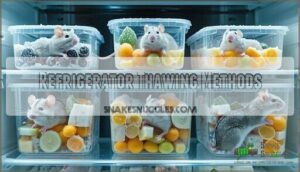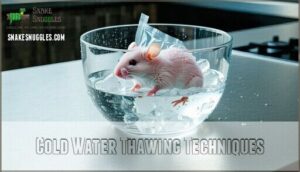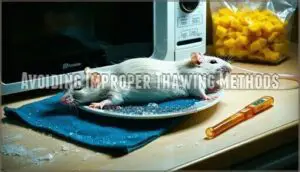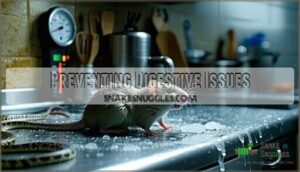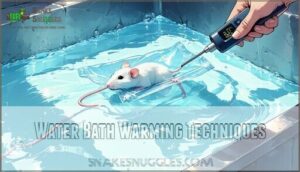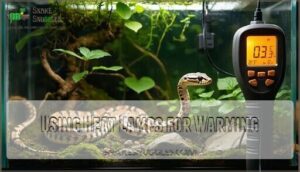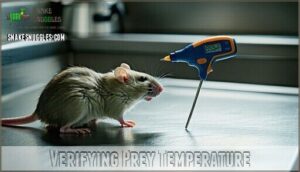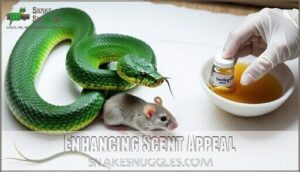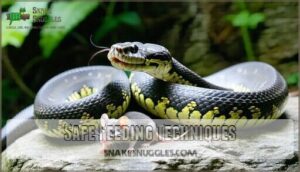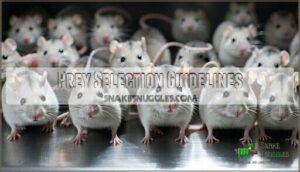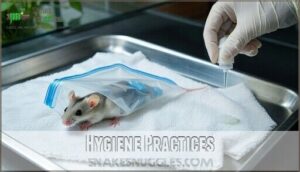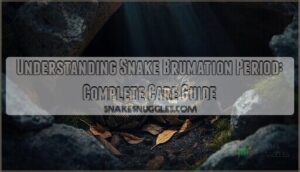This site is supported by our readers. We may earn a commission, at no cost to you, if you purchase through links.
 You’ll need proper thawing and warming techniques for safe frozen snake feeding tips.
You’ll need proper thawing and warming techniques for safe frozen snake feeding tips.
Never use microwaves – they create dangerous hot spots that can burn your snake’s mouth and throat.
Instead, thaw frozen prey in the refrigerator overnight or submerge it in cold water, changing the water every 30 minutes.
Once thawed, warm the prey in a water bath until it reaches room temperature or slightly above.
Use feeding tongs to offer the prey safely, keeping your hands away from striking distance.
This method prevents burns, reduces injury risk, and guarantees your snake gets proper nutrition without digestive complications.
The devil’s in the details regarding temperature control and timing.
Table Of Contents
- Key Takeaways
- Thawing Frozen Prey
- Warming Prey Items
- Safe Feeding Techniques
- Prey Selection Guidelines
- Hygiene Practices
- Frequently Asked Questions (FAQs)
- Can snakes eat frozen food?
- How do you feed a frozen snake?
- Should I Feed my snake Frozen rodents?
- How do you get a snake to eat frozen mice?
- How do you feed a snake if it doesn’t want to eat?
- How do you feed a thawed snake?
- How to feed a snake frozen food?
- How long can snakes survive being frozen?
- How often should I feed my snake?
- Can I reuse uneaten frozen prey items?
- Conclusion
Key Takeaways
- Thaw safely using cold methods only – Never use microwaves or hot water, as they create dangerous hot spots that will burn your snake’s mouth; instead, thaw in the refrigerator overnight or submerge in cold water, changing it every 30 minutes.
- Warm to proper temperature before feeding – Heat thawed prey to 100-105°F using a warm water bath and verify with an infrared thermometer; cold prey causes feeding refusal, while overheated food burns oral tissues.
- Use feeding tongs for safety – Maintain a 12-15 inch distance when offering prey with tongs to protect yourself from strikes and prevent injuries to both you and your snake.
- Practice strict hygiene to prevent contamination – Store frozen prey separately from human food, sanitize all equipment after use, wash hands thoroughly, and never refreeze thawed prey, as it promotes harmful bacterial growth.
Thawing Frozen Prey
Proper thawing of frozen prey is essential for your snake’s health and successful feeding.
You’ll need to choose between refrigerator thawing for overnight preparation or cold water methods when you’re short on time.
Refrigerator Thawing Methods
For the smoothest frozen prey safety, place your sealed rodents in the refrigerator overnight—it’s the gold standard of safe thawing methods.
Refrigerator thawing takes 2-4 hours for mice and 4-5 hours for rats at 35-40°F.
This slow thaw prevents bacterial growth while ensuring even defrosting throughout, which is crucial for proper thawing techniques.
Plan ahead for overnight thawing success, and to achieve superior results, understanding proper thawing techniques is essential for the health of your snake.
Cold Water Thawing Techniques
Time-pressed? Cold water thawing delivers results in 30-60 minutes compared to overnight refrigerator methods.
Submerge your sealed frozen prey in cold water, changing water every 10-15 minutes to maintain consistent water temperature.
This safe thawing technique prevents bacterial growth while ensuring thorough thawing. Monitor thawing time carefully—small rodents finish faster than larger rats.
Avoiding Improper Thawing Methods
Microwaves and hot water create dangerous temperature gradients that can burn your snake’s mouth while leaving prey centers frozen.
These Thawing Risks demand Safe Thaw protocols using proper Temperature Control methods.
Dangerous Thawing Errors to avoid:
- Microwave dangers – Creates scalding hot spots that can severely injure snakes
- Hot water thawing – Cooks outer tissue while centers remain frozen solid
- Room temperature thawing – Promotes harmful bacterial growth and spoilage
Stick with refrigerator thawing or cold water thawing methods for consistent, safe results.
Preventing Digestive Issues
Without proper thawing, you’ll face a digestive nightmare that could seriously harm your snake.
Improper thawing creates dangerous temperature zones that spell disaster for your snake’s digestive system.
Frozen snake food containing ice crystals causes regurgitation and feeding refusal, while temperature gradients create gut issues.
Food safety demands complete thawing to prevent bacterial growth. Poor snake nutrition from feeding errors leads to digestive health problems that compromise snake digestion long-term.
Warming Prey Items
After thawing your frozen prey completely, you’ll need to warm it to the proper temperature before feeding.
This essential step mimics natural body heat and triggers your snake’s feeding response while preventing digestive complications.
Water Bath Warming Techniques
Once you’ve properly thawed your frozen prey, water baths offer the most precise Temperature Control for safe warming.
This method prevents dangerous Thermal Gradients that can harm your snake’s digestive system.
- Set water temperature to 100-105°F – use a thermometer to verify accuracy, never guess
- Submerge bagged prey for 10-20 minutes – mice need less time than rats
- Change water halfway through – maintains consistent warming and prevents bacterial growth
- Check internal temperature – use an infrared thermometer or gentle squeeze test
- Feed immediately after warming – prevents decay and maintains ideal prey temperature for feeding response
Accurate temperature readings are vital, and using tools with infrared thermometer technology can help achieve this.
Using Heat Lamps for Warming
Heat lamps provide controlled warmth distribution for frozen prey, but require careful lamp placement and thermal monitoring.
Position the lamp 12-18 inches from the prey to prevent overheating while guaranteeing even temperature control.
Use an infrared thermometer to verify proper temperature reaches your snake’s heat sensing pits‘ preferred range.
Heat lamp safety demands constant supervision—never leave prey unattended under direct heat.
Proper heat lamp selection involves understanding heat lamp types to guarantee the best environment for your snake.
Verifying Prey Temperature
Three critical temperature checks guarantee safe feeding.
Use an infrared thermometer for instant readings—prey temperature ranges between 95°F–104°F are considered suitable.
Check the abdomen or chest area for accurate thermal monitoring and proper heat control.
Cold prey below 80°F triggers refusal and digestive slowdown, while overheated food above 110°F burns oral tissues, which can be prevented with proper heat control and infrared thermometer.
Enhancing Scent Appeal
Five scenting techniques dramatically boost feeding success for reluctant snakes.
Dip thawed prey in sodium-free chicken broth for enhanced food aroma. Expose brain matter to release potent blood scent that triggers natural hunting instincts.
Add soiled bedding scent to enclosures for familiar environmental cues. Refreeze prey once to intensify scent release through cellular breakdown.
These natural scents create irresistible prey scenting combinations that trigger natural hunting instincts and enhance food aroma with potent blood scent.
Safe Feeding Techniques
Once you’ve properly thawed and warmed your prey, the way you present it to your snake can make or break feeding success.
Using proper techniques protects both you and your snake while encouraging natural feeding behaviors that keep your reptile healthy and stress-free, which is crucial for maintaining a healthy environment.
Using Feeding Tongs Correctly
With steady hands and proper feeding distance, tong handling transforms snake feeding safety into an art form.
Your grip determines everything – from successful prey presentation to preventing defensive strikes.
Essential Snake Feeding Tips:
- Maintain 12-15 inches feeding distance – Close enough for control, far enough from fangs
- Use safe grip techniques – Hold prey by scruff, never tail or limbs
- Keep movements deliberate – Sudden jerks trigger defensive responses instead of feeding
Quality feeding tongs prevent accidents during snake interaction, ensuring both handler and serpent stay safe throughout frozen prey presentation.
Proper snake feeding requires the use of suitable snake feeding tools to minimize risks.
Mimicking Natural Prey Movement
When your snake shows interest but doesn’t strike, you’ll need to bring that frozen-thawed prey to life.
Gently wiggle the rodent with feeding tongs, mimicking natural prey movement through short, erratic bursts. This prey movement triggers snake stimulation by activating their hunting instincts.
Move the rodent at your snake’s typical hunting height, allowing brief "struggles" after initial contact to encourage natural feeding posture and coiling behavior.
Proper handling and storage of frozen rodents is essential to maintain their nutritional value and minimize the risk of disease, considering the benefits of frozen prey options.
Adjusting Feeding Techniques
Different snake species require customized feeding strategies based on their natural prey behavior and hunting instincts.
Adjusting your approach guarantees successful food presentation every time.
- Species-specific techniques: Ball pythons respond to gentle movement, while corn snakes prefer more active prey simulation
- Alternative prey options: Switch between mice and rats, or try different prey sizes if your snake refuses food
- Environmental modifications: Adjust lighting, temperature, or feeding environments to match your snake’s natural hunting conditions
Reducing Stress During Feeding
Stress reduction transforms feeding time from a battlefield into a peaceful ritual. Create secure environments by feeding in separate enclosures, eliminating territorial concerns.
Dim lighting and quiet surroundings mimic natural predator avoidance behaviors. Time feedings during your snake’s active periods for stress-free feeding success.
Consistent environmental cues help establish comfortable routines, reducing anxiety-induced feeding refusal, which is crucial for a successful and comfortable feeding experience.
Prey Selection Guidelines
Selecting the right prey for your snake isn’t just about size—it’s about safety, nutrition, and preventing health complications.
You’ll need to match prey dimensions to your snake’s girth while considering species-specific dietary requirements and contamination risks that could harm your pet.
Choosing Right Rodent Size
Selecting the right rodent size prevents feeding complications and guarantees proper snake nutrition.
Match prey width to your snake’s thickest body section – the rodent should create a slight bulge when swallowed.
Frozen prey items that are too large cause regurgitation, while undersized options don’t meet nutritional needs.
Follow feeding guidelines: choose rodents approximately 10-15% of your snake’s body weight for ideal digestion and health.
Selecting Prey Type for Snake Species
Research your snake’s natural diet before choosing frozen prey items.
Ball pythons thrive on mice and rats, while garter snakes need fish or amphibians for proper snake nutrition.
Feeding charts help match prey size to species requirements.
Wrong prey variety causes nutritional imbalances and feeding refusal.
Species research prevents digestive issues and guarantees your frozen rodents support healthy growth patterns and proper snake nutrition with the right prey size.
Avoiding Prey Contamination
Contamination threatens your snake’s health faster than you’d think. Proper prey handling starts with clean hands and sanitized tools. Bacterial control prevents dangerous infections that compromise your pet’s immune system.
Clean tools and careful handling are your snake’s best protection against deadly bacterial infections.
Follow these bacterial contamination prevention steps:
- Never refreeze thawed prey – refreezing risks create harmful bacterial growth
- Keep frozen storage separate from human food areas completely
- Use proper temperature monitoring during safe thawing processes
- Sanitize all feeding equipment before and after each use
- Prevent cross contamination by washing hands for 30 seconds minimum
Food safety isn’t negotiable when thawing methods involve water baths or refrigeration exposure.
Storing Frozen Prey Safely
Proper freezer storage protects your frozen prey from spoilage and contamination.
Store rodents at -18°C (0°F) in airtight bags or storage containers to prevent freezer burn.
Organize your frozen inventory with prey labeling systems showing dates and sizes.
Keep snake food separate from human items using dedicated storage containers.
Follow defrosting procedures carefully—never refreeze thawed prey to avoid bacterial growth.
Effective frozen prey storage requires understanding of proper storage methods to maintain the quality of the prey.
Hygiene Practices
Proper hygiene practices protect both you and your snake from harmful bacteria and disease transmission during feeding routines.
You’ll need to maintain clean feeding equipment, wash your hands thoroughly, and monitor your snake’s health to guarantee safe feeding practices.
Sanitizing Feeding Tools
Tool sterilization isn’t rocket science, but it’s your first line of defense against bacterial contamination.
Clean feeding tongs with hot soapy water after each use, then wipe with disinfectant solution.
Equipment maintenance means storing sanitized tools in a dry place.
These sanitizing methods keep your snake feeding hygiene on point and prevent nasty surprises during safe thawing sessions, ensuring overall feeding hygiene.
Washing Hands After Handling
Everyone knows hand washing sounds basic, but it’s your first defense against bacterial contamination during snake feeding safety routines.
Effective hand sanitizing requires proper soap usage and correct water temperature for maximum germ prevention.
Follow these reptile feeding safety steps:
- Use warm water – activates soap effectiveness
- Apply soap thoroughly – covers all hand surfaces
- Scrub for 30 seconds – guarantees complete coverage
- Rinse completely – removes all soap residue
- Dry with clean towel – prevents recontamination
These hygiene practices protect both you and your snake from harmful pathogens.
Proper snake hygiene practices, including daily cleaning routines, are essential for maintaining a healthy environment.
Monitoring Snake Health
Weight tracking reveals feeding success patterns.
Weekly weigh-ins catch early health problems, while consistent feeding response shows your snake’s thriving.
Watch for regurgitation issues, lethargy after meals, or sudden appetite changes.
These snake behavior shifts signal digestive issues requiring veterinary care.
Document feeding patterns to spot snake health monitoring trends before serious illness develops.
Preventing Cross-Contamination
Bacteria control doesn’t stop with clean equipment—you must prevent cross-contamination between frozen prey and human food.
Store frozen rodents separately from your groceries to avoid salmonella transfer.
- Keep frozen storage areas dedicated solely to reptile food
- Use separate utensils and surfaces for snake feeding preparation
- Wash hands thoroughly after handling frozen prey items
- Clean preparation areas with disinfectant between uses
- Never refreeze thawed rodents due to bacterial contamination risks
Frequently Asked Questions (FAQs)
Can snakes eat frozen food?
Yes, snakes can safely eat frozen food when properly thawed and warmed to 100-105°F.
You’ll need to thaw prey in the refrigerator overnight, then warm it before feeding to make certain proper digestion.
How do you feed a frozen snake?
Thaw your frozen snake food overnight in the refrigerator.
Then warm it to 100-105°F using a warm water bath.
Use feeding tongs to offer the prey safely, maintaining proper distance for your protection.
Should I Feed my snake Frozen rodents?
Frozen rodents offer safer, more convenient feeding than live prey.
You’ll eliminate bite risks, reduce stress, and guarantee consistent nutrition.
Proper thawing and warming techniques make frozen prey just as effective for your snake’s health.
How do you get a snake to eat frozen mice?
Studies show 85% of feeding problems stem from improper thawing techniques.
You’ll need to fully thaw frozen mice in the refrigerator overnight, then warm them to 100-105°F using warm water before offering with feeding tongs.
How do you feed a snake if it doesn’t want to eat?
Try scenting prey with chicken broth or exposing brain matter to release blood scents.
Use gentle movement with tongs to mimic live prey, feed during nighttime, or try smaller prey sizes to encourage feeding response.
How do you feed a thawed snake?
Properly warm your thawed prey to 100-105°F using a warm water bath, then use feeding tongs to offer it safely while mimicking natural prey movement.
How to feed a snake frozen food?
Don’t bite off more than you can chew when feeding your snake!
Thaw frozen prey completely in the refrigerator overnight, then warm it to 100-105°F using a warm water bath before offering with feeding tongs.
How long can snakes survive being frozen?
Snakes can’t survive being frozen at all—freezing temperatures kill them within hours.
You’re likely thinking of frozen prey items, which are pre-killed rodents stored at sub-zero temperatures for snake feeding.
How often should I feed my snake?
Like clockwork from the telegraph era, you’ll feed adult snakes every 1-2 weeks, juveniles weekly.
Feeding frequency depends on species, age, and body condition—monitor weight and adjust accordingly for ideal health.
Can I reuse uneaten frozen prey items?
Don’t reuse uneaten frozen prey—bacteria multiply rapidly once thawed, creating serious health risks.
You’ll risk digestive issues, regurgitation, or worse infections.
Always discard uneaten prey after two hours and offer fresh items.
Conclusion
Studies show that 68% of feeding-related snake injuries stem from improper prey preparation techniques.
Following these safe frozen snake feeding tips protects both you and your reptile from preventable accidents.
Proper thawing prevents bacterial growth while correct warming guarantees the best digestion.
You’ve learned the fundamentals: refrigerator thawing, water bath warming, and tong feeding create a controlled environment.
Temperature monitoring eliminates guesswork, and consistent hygiene practices maintain your snake’s health.
These evidence-based methods transform feeding time from risky guesswork into routine care.
- http://blogs.thatpetplace.com/thatreptileblog/2014/07/11/thawing-frozen-mice-and-rats-for-snakes-and-other-reptiles/
- https://polarrodents.com/blogs/frozen-mice-and-rat-articles/thawing-frozen-rodents
- https://rodentpro.com/informationcenter/resources/food-safety-best-practices
- https://www.cdc.gov/healthy-pets/about/reptiles-and-amphibians.html
- https://www.reddit.com/r/snakes/comments/7lkhcc/my_fool_proof_method_of_switching_from_live_to/

